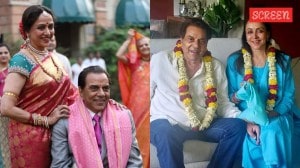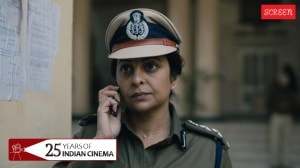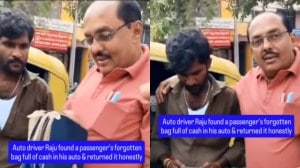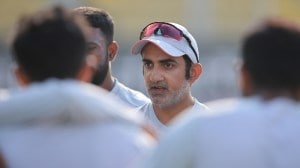Click here to follow Screen Digital on YouTube and stay updated with the latest from the world of cinema.
Kanu Behl is hopeful Yash Raj Films would back an indie film like Titli today: ‘There’s still no sustainable system for independent cinema’
In an exclusive interview with SCREEN, Titli director Kanu Behl looks back at his 2015 directorial debut, how autobiographical that story was, learnings from Dibakar Banerjee, and whether Yash Raj Films would back an indie film like that today.
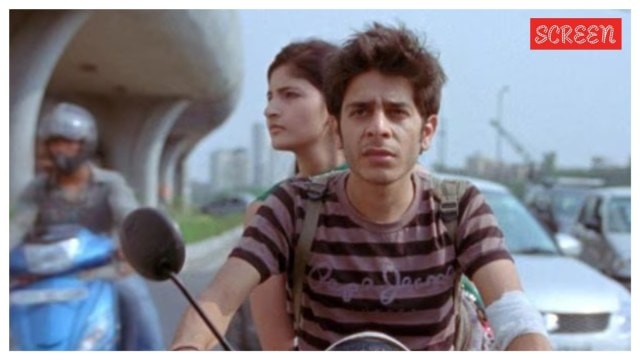 Shashank Arora and Shivani Raghuvanshi in Kanu Behl's Titli.
Shashank Arora and Shivani Raghuvanshi in Kanu Behl's Titli.2015 was an interesting year for Aditya Chopra’s Yash Raj Films. Alongside the gentle small-town romance Dum Laga Ke Haisha, the banner also released Dibakar Banerjee’s period thriller Detective Byomkesh Bakshy! The year concluded with yet another collaboration between Banerjee and YRF, Kanu Behl’s acclaimed directorial debut, Titli. An indie film starring Ranvir Shorey, Amit Sial, and Lalit Behl, and marking the debut of Shashank Arora and Shivani Raghuvanshi, it was unlike anything YRF had put its might behind till then and ever since.
Now, 10 years later, in an exclusive interview with SCREEN, Kanu Behl looks back at his seminal film, how autobiographical it is, and whether a big production house would back a small film like Titli anymore.
Shivani Raghuvanshi told me that when she auditioned for a Yash Raj Films movie titled Titli, she assumed she’s going to wear the chiffon sari and run around trees. But of course, it turned out to be exactly the opposite. Where did that title come from?
I think the title came pretty early. It was there while Sharat (Katariya) and I were writing the two-pager or five-pager. The idea behind that was in certain areas like Eastern Delhi, people were hardly called by their real names. They all had nicknames. I remember Bawle’s (Amit Sial) real name was Pradeep, but we never hear it throughout the film. Similarly, Titli’s real name is Rohit. I don’t even remember Vikram’s (Ranvir Shorey) anymore. So, we thought Titli was a very good title for the film. I was very aware how fragile that boy was in this house. Since titli (butterfly) also symbolizes transformation, we also wanted him, as the protagonist of the story, to obviously say something about the film in the end.
Three brothers in a patriarchal world, the youngest being the most fragile (Naseeruddin Shah), influenced by an outsider woman (Shabana Azmi), was Shyam Benegal’s Nishant (1975) somewhere an influence on Titli?
Not at all. For me, it was such a personal film and I was so closely attached to it, that I didn’t look for anything else. The original, external inspiration was this article I read in The Indian Express, by the way, about a gang of carjackers who were brothers. That was interesting. That was the seed. After that point, I was putting so much of myself in the film that getting influenced by any other film was out of question. But now that you mention it, there are certain similarities probably.
 Smita Patil and Naseeruddin Shah in Nishant.
Smita Patil and Naseeruddin Shah in Nishant.
Amit Sial told me that his most striking memory from shooting Titli was when he’d cross the lane where you shot the film in Delhi and see the dwellers there and how miserably they lived. What are your memories of growing up in that part of Delhi?
It wasn’t like I was watching these spaces in a peripheral way. For a few years, I was part of those spaces. My experience there was as a participant. Yes, I’d grant I was slightly privileged. My parents were doing well. A few years later, they managed to buy a house in Patparganj, which is just 1 degree of separation from Mandawali. So, I’ve looked at it too closely. One of my aunts had a house there. The drain below the steps to enter the house was uncovered and completely clogged. One time, when I was six, I fell into that drain because the stairs gave way. After that point, I was always scared to take those stairs. I’ve tried to recreate many of those visuals in the film. For example, the house in which Vikram’s wife lives with her new boyfriend and little daughter, most of the furniture there is from a house I lived in. I’ve slept on that bed and played on that sewing machine. Not to mention all the boys playing marbles or cricket with the thaapi (washing bat in Punjabi).
You’ve worked as an Assistant Director with Dibakar Banerjee on Oye Lucky! Lucky Oye! (2008) and Love Sex Aur Dhokha (2010), whose depictions of Delhi were quite different. He was also a producer on Titli. What have you learnt from him as a filmmaker?
The biggest thing to learn from Dibakar was his rigour and pure love for film. I can very confidently say I haven’t met anyone in this town who loves cinema more than probably Dibakar. Anurag Kashyap comes very close to that. But Dibakar’s love for cinema is a particular kind, almost like a devotion. He likes to take on a certain divine journey with every aspect, especially writing. I’ve learnt a lot from that on not only Oye Lucky! Lucky Oye! and LSD, but also on the writing process of Titli. The feedback we got from him on each draft was invaluable. He could easily turn around and say this scene isn’t there yet and we need to do more work on that.
But the focus and the need to constantly push were the biggest lessons for me. Even though I was from a film school myself and felt about films deeply, that man’s love for cinema is infectious. Another big lesson was how calm he was on set. He’d make the day fly with complete composure. Before that, my learning was slightly different. My dad had bit of a temper, so the sets were quite chaotic. So I realized you didn’t have to be belligerent.
 Dibakar Banerjee and Kanu Behl.
Dibakar Banerjee and Kanu Behl.
Do you remember any specific input from him that you initially didn’t agree with, but it eventually made it to the film and even made it better?
I have a very particular memory about a thing we argued the most about. But he won in the end because he was the producer (laughs), not because he enforced it. I always wanted to end the film with a top shot of Titli after he apologizes to Neelu (Shivani Raghuvanshi). But Dibakar always insisted to have that scooter ride in the end. I thought it might give hope. I wanted to end with the perpetrator. Eventually, Dibakar played the producer card and said just shoot it even if you don’t end up using it. It was built to give some kind of hope. The way I looked at that image was: even though they’re going somewhere, where would these two broken people end up?
Since you had a difficult relationship with your father Lalit Behl, was there a symbolic reason behind casting him as the patriarch of that house?
Actually, no. I wasn’t fully convinced about that choice because I had such a fraught relationship with him. In fact, he was also not convinced till the last moment. I remember him telling me since it’s my first film, he doesn’t want anything to do with it so that I don’t blame him later if anything goes wrong. But what convinced me was that my close collaborator Atul Mongia, also my associate director and casting director, had tested a lot of people, but we weren’t convinced. His casting came up, but I vehemently opposed it. But he said there’s great merit in doing it because the physical, unsaid rhythms you’re trying to create, he already knows them, so you won’t have to do much. That argument was valid. So I decided to go ahead and find ways to deal with the other stuff. It was a difficult part because it was a silent part. If you look at it, he has only two speaking scenes. So, it was very important for that rhythm of the violence to be present throughout.
 Lalit Behl in Titli.
Lalit Behl in Titli.
Now that he’s no more, how do you look back at the relationship with your dad?
I don’t like to romanticize things. Was just the act of making the film a catharsis for me? No, it wasn’t. I had processed quite a bit of the relationship already in my head, heart, and soul. And that had led to the process of making the film. You have a life, you live your life, it’ll be lived the way you live it, and it’s done. Things aren’t going to change. I don’t have a different perspective on what happened and who he was because I loved him when we had a fraught relationship and I’ve loved him since. It’s not even a regret, but the only thing I probably miss is I couldn’t meet him when he passed away. I was stuck in Mumbai in Covid. By the time I got to Delhi, he was already unconscious in the hospital.
Your mother, Navnindra Behl, also an actor, was always around even when you had a fraught relationship with your father. But in case of Titli, there’s no matriarch, no towering female presence. Do you think that house would be different if there was one?
It’s an interesting question. I’d like to believe and hope they would have been different. Having said that, I’ve seen houses and families where that’s not the case despite there being a feminine presence. It’s slightly strange because in a way, Bawla is a feminine presence in that house. Women, maybe even regardless of class, have a way to tackle all the masculinity and testosterone. They somehow get their way. You can see Bawla pull off those strings. It’s also what I’ve experienced in the milieu the film is set in that the men don’t agree by belligerence, but women have another way of getting things done. They hold a degree of power themselves, some of which you see in Shivani’s character and Vikram’s wife. So, women are actually very interesting creatures in that film.
 Kanu Behl with his parents Lalit Behl and Navnindra Behl.
Kanu Behl with his parents Lalit Behl and Navnindra Behl.
I don’t think YRF has made as gritty a film after Titli. Do you think it was a miracle that can’t be recreated anymore?
I hope not. But yes, there’s no sustainable system for independent cinema. There was probably in the 1970s and early ’80s with NFDC (National Film Development Corporation) in their best years, and perhaps those mid-2000s to 2010s where we felt a little hope. But things have gotten tougher and tougher for independent cinema. Having said that, maybe they were always that tough. The only difference between here and Hollywood is that they have better actors, who are not only better at their craft but also willing to do different kinds of stuff instead of doing only what enhances their brand. Because ultimately everywhere, the budget of your film depends on who’s in it. So here, who do you really go to who’ll get your film some money, yet at the same time, not piss all over your film?
But even the independent scene of Hollywood is struggling, given that Leonardo DiCaprio-Paul Thomas Anderson’s One Battle After Another and Dwayne Johnson-Benny Safdie’s The Smashing Machine have underperformed despite boasting of A-list stars. How do you view that?
The Hollywood independent scene is also going through a churn right now, but it’ll remain alive because there are some 40 really interesting actors. A Dwayne Johnson is willing to push the envelope with a Safdie.
That’s true because while Dwayne Johnson has stood by The Smashing Machine despite it being his lowest earning film in years, Hrithik Roshan claimed after the failure of Vikram Vedha (2022) that it’s not the kind of role his fans want to see him in. Hence, comes a War 2. Why is there so much dissonance in our A-list stars and Hollywood’s?
It’s futile to talk about people who are essentially closed in a room with 10 voices that create echo chambers for them and probably have very little connection left with reality. I find it a waste of time to talk about them, especially in an era where DiCaprio works with Paul Thomas Anderson. It’s done really well for both of them. So, those who say, “This isn’t my audience,” they’re not the ones saying that. They’re just insecure, and it’s only the 10 people around them who are saying that. Nobody knows where the audience is going and what’s changing. They want to watch all kinds of stuff now. We blame it on Covid, but that’s just an excuse. It’s just quickening their disinterest. You can see the results of that in the 4-5 big names that we like to call them. It’ll take its own path and find its own destination very soon.
The two indie filmmakers you look up to — Anurag Kashyap and Dibakar Banerjee — are also struggling. Anurag’s latest film Nishaanchi has tanked at the box office while Dibakar’s Tees never saw light of the day. Where’s the hope for smaller indie filmmakers then?
We need to have a bigger conversation. Who is even a filmmaker and what is even the act of making a film? The bigger struggle is for the rickshaw wallah, the grocery shop owner, the porter at the railway station. Those are the guys who are really suffering. That’s what’s wrong, and that’s why independent cinema is struggling. It’s not because a few people are deciding not to do films with another few. Of course, that’s difficult. But at the end of the day, I don’t forget my own privilege even for a second. No one owes me anything. If I’ve chosen to make a certain kind of film, I need to figure out a way. Yes, I have to process the truth there’s no structural support in this country. But we all need to ask the larger questions of what’s playing at the bigger socio-political level which is affecting the overall cultural landscape. What we’re losing is the ability to have a nuanced conversation about anything.





- 01
- 02
- 03
- 04
- 05















